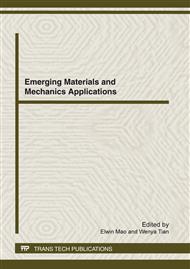p.401
p.406
p.411
p.416
p.423
p.427
p.435
p.440
p.445
Research on the Fatigue Fracture Surface of X60 Pipeline Steel after per-Tension Deformation
Abstract:
It is impossible to keep pipelines free from defects in the manufacturing, installation and servicing processes. In this paper, pre-tension deformation of X60 pipeline steel was employed to experimentally simulate the influence of dents and the fatigue fracture surfaces of X60 pipeline steel after per-tension deformation under cyclic loading were investigated. The results indicate that the static state tensile mechanics is the dominant factor in the fracture mechanisms at high stress ratio. With the decrease of the stress ratio R, the fractograph presents evident fatigue facture characteristics. The amount and intensity of MnS inclusion evidently increase with the loading frequency decrease and the typical cleavage fracture characteristics have been found.
Info:
Periodical:
Pages:
423-426
Citation:
Online since:
March 2012
Authors:
Keywords:
Price:
Сopyright:
© 2012 Trans Tech Publications Ltd. All Rights Reserved
Share:
Citation:


